Abelmoschus esculentus
Okra, referred to by the botanical name Abelmoschus esculentus or sometimes Hibiscus esculentus, is a member of the Malvaceae, or mallow family, that includes cotton, hibiscus, and hollyhocks.
It is thought to have origins in ancient Egypt and Ethiopia, and grows as an annual in all USDA Hardiness Zones.
Also called lady finger or gumbo, the immature edible pods of okra have long been used as a thickener in stews and soups like Creole- and Southern-style gumbo, and Indian dishes.

We link to vendors to help you find relevant products. If you buy from one of our links, we may earn a commission.
Read on for all you need to know to grow and harvest your own crop, plus some info on varieties and useful cooking tips!
How to Grow Okra
Okra Orientation
Rich in fiber, protein, and vitamins A, C, and K, okra is not only a nutritious addition to veggie gardens, but makes an attractive specimen in beds and borders, with varieties ranging from dwarf to over eight feet tall at maturity.
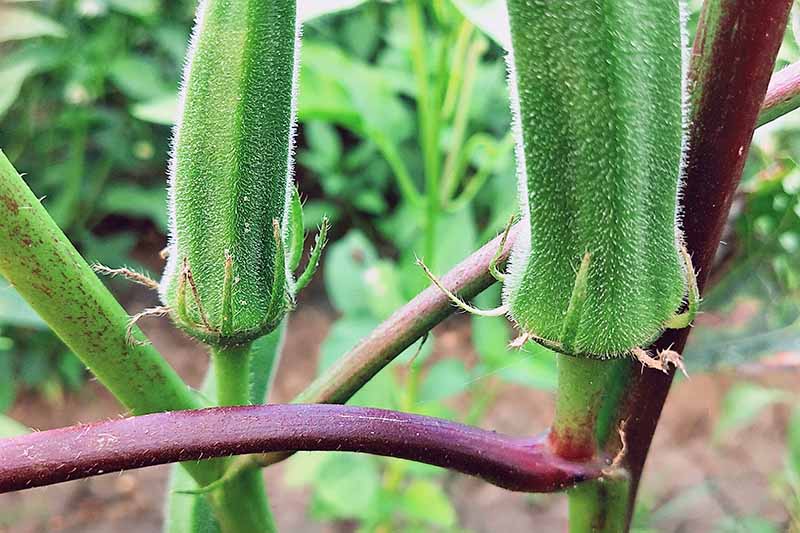
Plants are typically green, but may also be red-stemmed with red-veined leaves.
Yellow flowers with red centers resemble hibiscus. Pods may be green or red; curved or straight; with or without ridges; and smooth or covered in tiny fuzzy “spines.”
In fact, the leaves, stems, and pods of this plant are often setulose, or covered in tiny hairs or bristles. Though these aren’t technically spines like what you might find on a cactus, they’re commonly referred to as such, and they can be a real pain for whoever is doing the harvest.
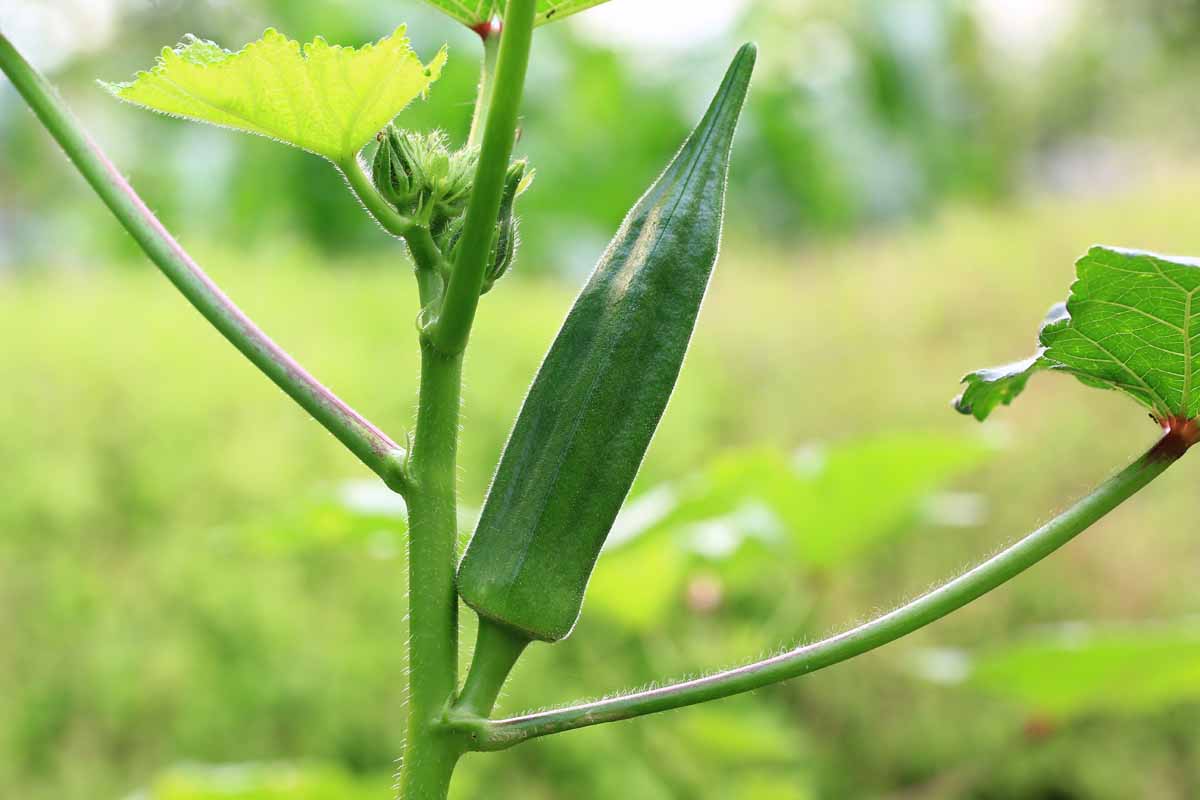
Gardeners often prefer “spineless” varieties, because these protrusions commonly cause itching and irritation when okra is harvested and prepared. For some, handling the plant may actually cause an allergic skin reaction.
Much like stinging nettles, washing and cooking, or blanching in boiling water, will remove these irritating hairs. Wearing long sleeves and gloves to protect your skin is always recommended when you’re working in the garden.
Growing Tips
Okra is very easy to grow from seed.
It prefers full sun, average moisture without letting the soil dry out completely if possible, and good soil that drains well. A neutral soil pH between 6.5 and 7.5 is preferred.
It will grow in poor soil and can even withstand some drought conditions, but may not produce optimally under these circumstances.
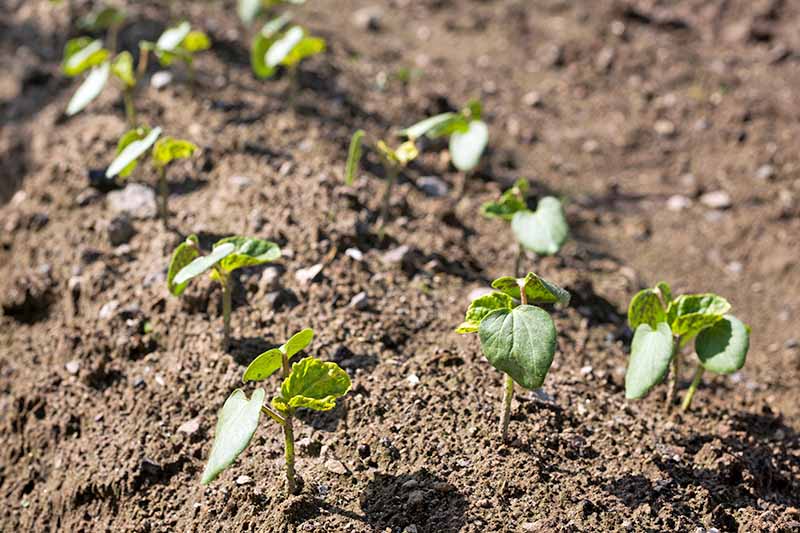
Prepare seeds for planting by scraping each lightly with a nail file and soaking in tap water overnight.
In warm climates, direct sow in the early spring garden when soil temperatures are at least 60°F, to a depth of about one inch. Around mid-summer, you may prune tall varieties to encourage further growth, and you can also choose to plant a fresh crop at that time for a late harvest.
In cold regions, like mine in the Northeast, you’ll have to wait a little longer for the soil to warm up enough for direct sowing outdoors, at least two weeks after the last frost date, maybe more. You may also start seeds indoors up to two months before the last average frost date in spring. Since the soil needs to be warm to encourage germination, consider using a heat mat.
Transplant sturdy seedlings to the outdoor garden around the last frost date. I like to use egg cartons or peat pots I can place directly into the ground, because okra has fragile roots. Keep in mind that okra doesn’t take well to transplanting, so you’re likely to lose some seedlings if you go with this planting method.
Be sure to read seed packages for specific instructions, and for details on plant heights and widths. Tall types reach up to four feet in diameter, and this knowledge will aid in spacing your plants in the garden.
Sow more seeds than you need, and when sprouts have their first true leaves, thin them out, keeping only the strongest.
Apply a layer of mulch around your plants to inhibit weed growth and aid in moisture retention. Feed with a balanced vegetable fertilizer throughout the growing season, per package instructions.
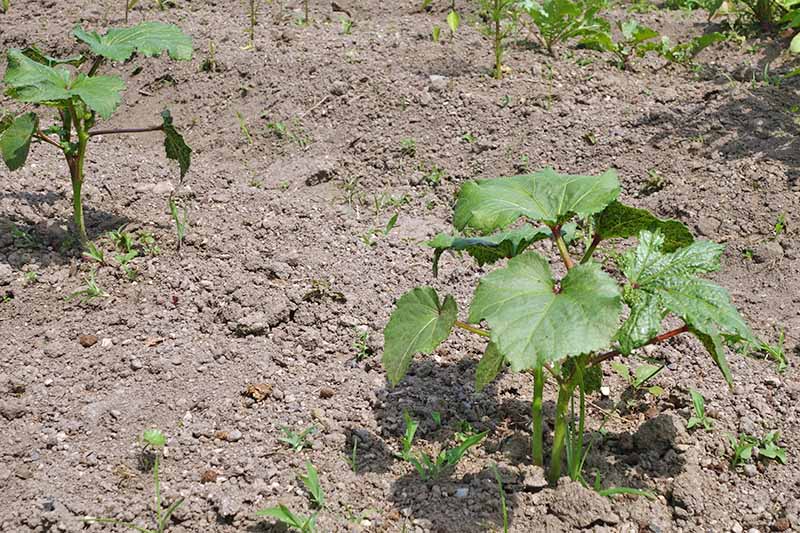
Extreme weather fluctuations can affect this plant, causing flowers and buds to drop, or pods to fail to form. Give your plants the best conditions you can in terms of sun exposure, provide adequate watering and sun protection to try to keep your plants cool in a heatwave, and cover seedlings for extra warmth in the case of a late-season coldsnap.
Pests and Disease
Okra is not particularly prone to pests or disease, but both are always a possibility.
Avoid the need for troubleshooting later with crop rotation, high quality seed, ample air circulation, and appropriate moisture. Keep your veggie patch clean, and remove dead leaves and old vegetation.
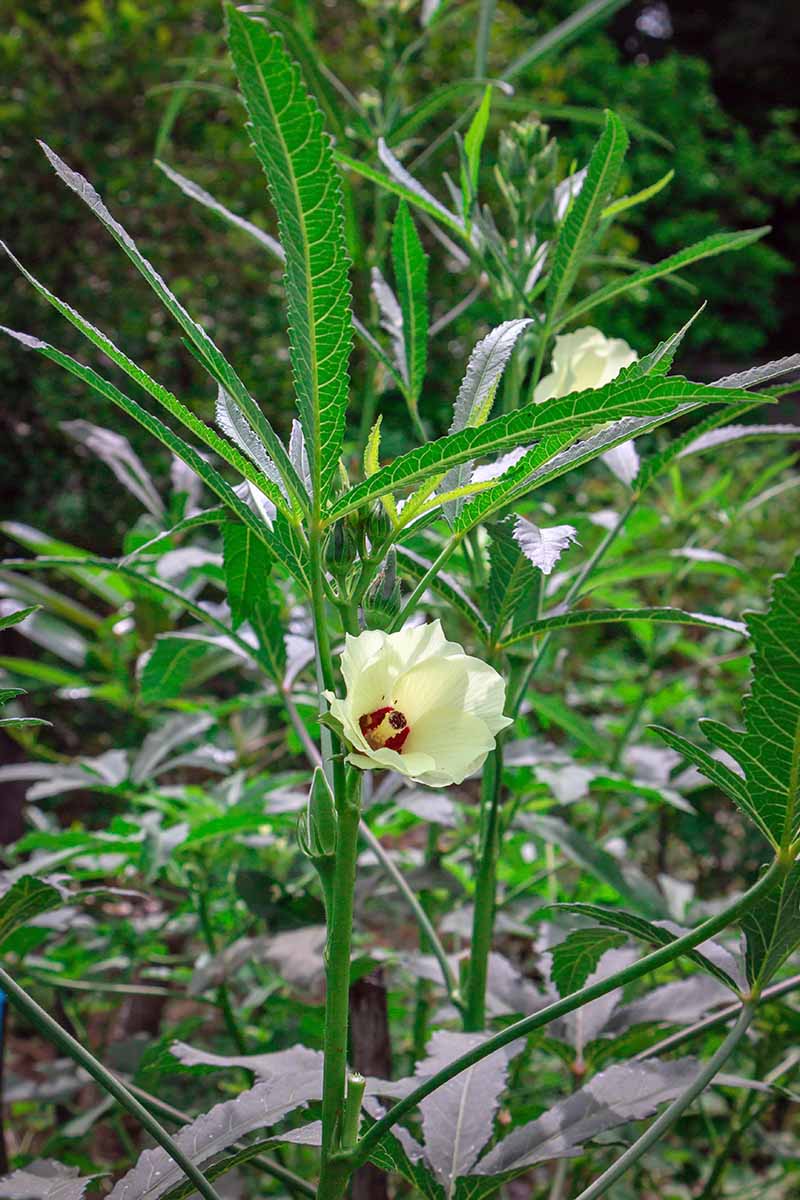
Walk through your garden each day, and be on the lookout for aphids and stink bugs feeding on the juices of emerging pods. Remember that beneficial insects like ladybugs are your friends in the veggie patch, and they should be allowed to stay!
Look for cabbage worms and flea beetles munching leaves, and check the undersides of leaves for bug eggs and whiteflies.
Hand picking insects or dousing them with a steady stream of hose water is usually all that’s needed to avoid an infestation.
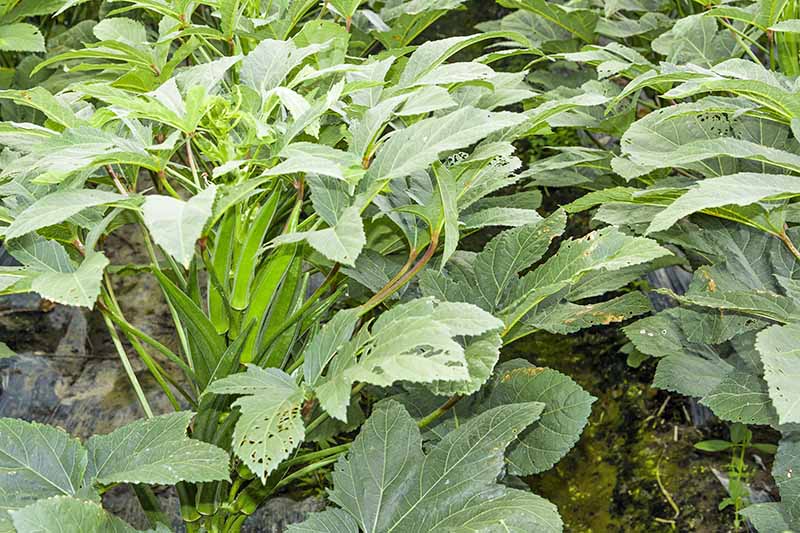
In addition, a fungal disease called fusarium wilt may occur where there is too much moisture. Its telltale sign is drooping yellow leaves. Plants that succumb to this must be destroyed, to prevent spread to other plants.
Anthracnose fungus is another potential issue, noted by black spots on leaves. Again, you should remove any infected plants to prevent further spread in the garden.
Powdery mildew, noted by white and powdery spots on plants as the name suggests, may also affect okra growing in humid and overly moist conditions. Remove affected portions, prune back plants for good airflow, and always plant in well-draining soil.
Read more about treating powdery mildew disease.
Suggested Okra Varieties
Okra is a cultigen, meaning it has been improved upon via selective breeding and hybridization for many generations, to produce the most delicious harvests and attractive, resilient plants.
You’ll find an array of cultivars available from all over the world that includes heirloom species and hybrid varieties. And while the flavor of the resulting fruits is generally mild, aficionados of old heirlooms often swear their favorites are best.
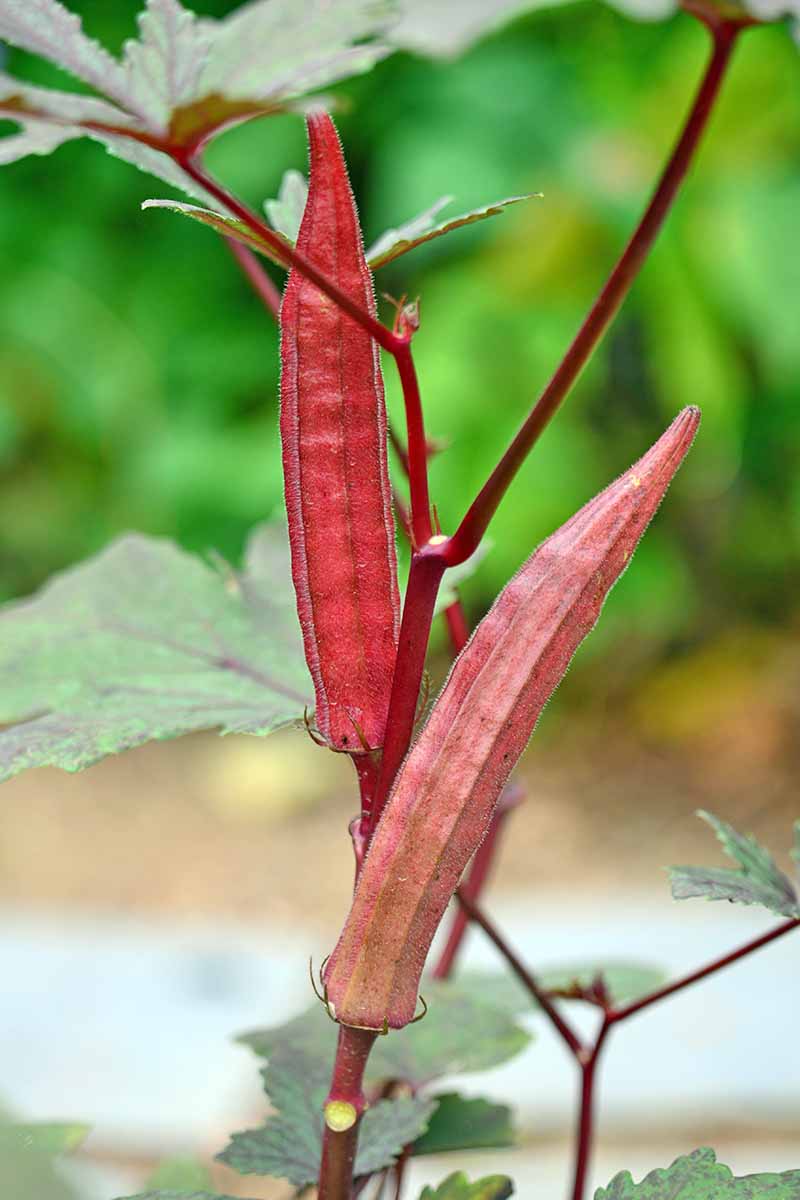
If you garden in the South, all varieties should serve you well, as okra loves heat, humidity, and a long growing season. For Northerners, cultivars bred for better cold tolerance and a shorter growing season are best.
If you’re looking for something unique, you can find okra in shades of red and burgundy. To save your skin, look for spineless varieties – but keep in mind that no cultivar is truly entirely free of those potentially irritating little hairs that grow on the plant.
Here are a few noteworthy varieties that you might like to choose for this year’s garden:
Cajun Delight
If you’re growing in a cooler climate up north like me, this hybrid is a great pick. Plants mature in 50-55 days, maxing out around 4 feet in height. Dark green pods grow to about 5 inches long, with a slight curve.

Hybrid ‘Cajun Delight’ seeds are available from Seedsurvivor via Amazon.
Burgundy
For something a little different, add some color to your crops. This red variety matures in 60 days, reaching four feet in height.
Straight pods will grow up to eight inches long, if you want to keep them on your plants for ornamental interest.
Heirloom ‘Burgundy’ seeds are available from Eden Brothers.
Want more options? Check out our Guide to the Best 13 Varieties of Okra.
Harvest Time
You want to harvest your okra when it’s around three inches long which is the optimal size for most cultivars before they start getting woody. If they are too tough and stringy at that length, you can start harvesting them two inches.
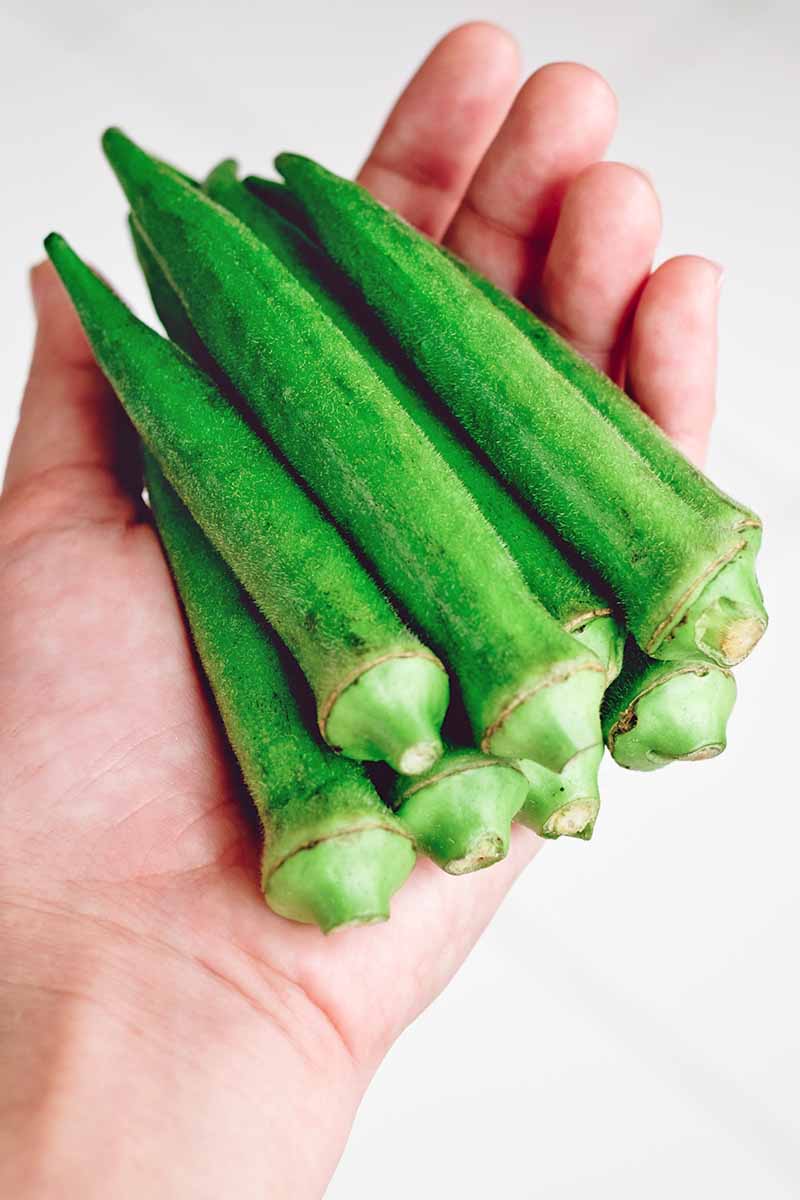
If you pick ever other day and keep on top of them, your pods should keep blooming and produce tasty pods all summer long. And if you have planted open pollination varieties, remember allow a few to grow to maturity to save their seeds for next year’s planting.
Get more details on okra harvesting here.
Okra Quick Reference Growing Chart
| Plant Type: | Annual | Tolerance: | Drought |
| Native to: | Tropical Africa and Asia | Maintenance: | Moderate; keep free from weeds |
| Hardiness (USDA Zone): | 9-12 | Soil Type: | Loamy |
| Season: | Summer | Soil pH: | Slightly acidic to slightly alkaline, 6.5-7.5 |
| Exposure: | Full sun | Soil Drainage: | Well-draining |
| Time to Maturity: | 50-60 days, depending on cultivar | Companion Planting: | Melons, cucumbers, sweet peppers, eggplant |
| Spacing: | Thin to 12 inches | Avoid Planting With: | Short, sun loving veggies and flowers whose light may be blocked |
| Planting Depth: | 1 inch or less | Order: | Malvales |
| Height: | 3-6 feet | Family: | Malvaceae |
| Spread: | 12-48 inches depending on cultivar | Genus: | Abelmoschus |
| Water Needs: | Moderate, every 7-10 days | Species: | esculentus |
| Common Pests: | Aphids, armyworms, cabbage loopers, corn earworms, cucumber beetles, flea beetles, stink bugs, thrips, root knot nematodes, spider mites | Common Disease: | Charcoal rot, fusarium wilt, powdery mildew, southern blight, white mold, yellow vein mosaic virus |
Edibles Rule
There are so many reasons to add okra to your garden planner this growing season. Whether you cultivate it as a vegetable for the table, or a decorative specimen in beds and borders, it’s going to make a bold statement in your outdoor living space.

Easy to grow and virtually trouble free with the right conditions, okra’s hibiscus-like yellow blossoms and pods of striking proportions offer season-long interest, and the opportunity for gardening fun with the family.
Remember, the more nutritious veggies your garden grows, the healthier you can be. You’re not going to want to let that fresh produce go to waste when you grew it yourself! Why not dedicate more of your landscape to the cultivation of edible plants, and make every square foot count.
And for more veggie related growing guides, be sure to check some of these out:
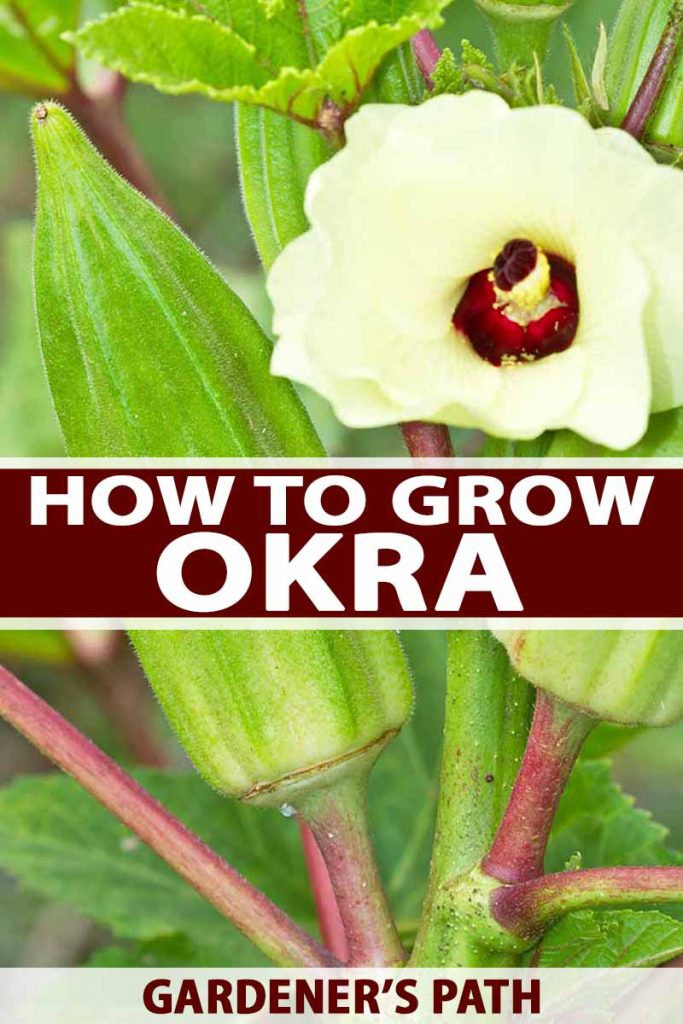
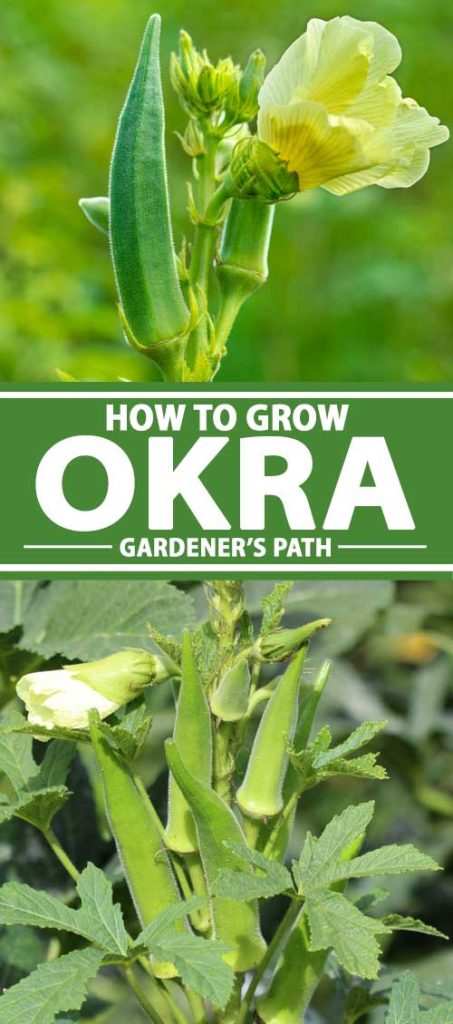
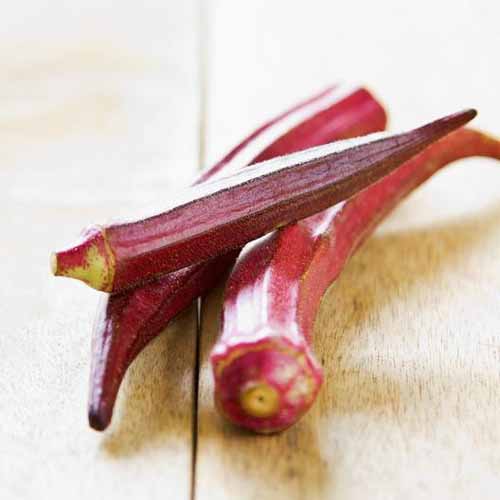
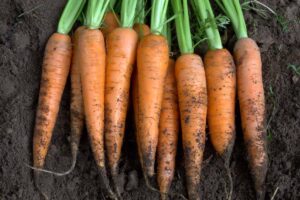

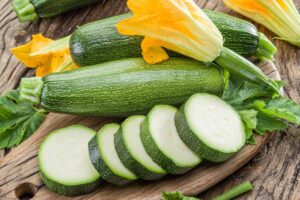
Hello, I noticed in many instructions for germinating seeds of many plant types, the instructions include soaking the seeds over night or even longer. I would like to ‘respectfully’ bring this process up to date. Most seeds need to be submersed in water for 2-3 hours at the most! many for less time. The physiological reasons are clear once you have some basic information. Using Turf-grass seeds as an example; the seed should only be soaked in water for a Maximum of 2.5 hours. the reason is as follows – the seed imbibes all the moisture it can use in… Read more »
Interesting observations, Mr. Johnson. Okra has a hard seed coat, and soaking is recommended to encourage germination. A short period of soaking may work for grass seed, but soaking for longer periods is generally recommended for this type of seed.
Good information. For Okra yesterday I soaked overnight in a lean solution of Atonik with tissues inside and all had sprouted and I planted them in nursery today. I learnt that for snake gourd and bitter gourd you have to damage the shell near the embryo carefully without damaging the embryo to speed up germination.
i have a garden of about 50pcs okra plants, some of them are above 3 and 4 ft tall but not producing fruit but instead growing more and bigger green leaves and what I will call it suckers has grown all over the stem but not baring fruits is my concern now because I have beautiful okra plants, can you tell me what is causing them not bare fruits?
Thank you
Hello Charles –
I recommend that you have your soil tested to determine its acidity and nutrient content. Okra prefers soil that’s near neutral. In addition, plants that get too much nitrogen from fertilizers often produce an excess of foliage. And, plants that are too close together are subject to fungal infection. Your local cooperative extension service is an excellent resource for determining issues specific to your garden.
Prune it and see. Also use a fertilizer with higher P and K like Moringa leaves and banana leaves fermented in water for about 3 weeks.
Hello! Are okra plants pulled out or pruned? When is the best time to pull them out or to prune? How do I make it bushy and more productive? Thanks/
Hello Oliie –
In late summer, you can prune okra back by up to one-third to encourage a late season crop. At season’s end, you can pull up entire plants.
I always cut the leaves below the fruit, since it only produces up the stalk. I have okra until frost, at which time I pull up the stalks.
Also, I dehydrate okra and use it in gumbo, and soups. Last year I rehydrated in boiling water, drained and fried like fresh. We couldn’t tell the difference.
I grew short stocky variety shown in first picture. The trees grow 8 feet tall and take about 8 months to grow and started blooming only now in December. Last planting too was like that and wife uprooted and destroyed most of the plants but this time I did not allow her. She cropped the tree and it branched off 2-3 branches and each are productive and so are the small trees that did not grow that well, all are blooming and we pluck every other day. I had the mealybug, caterpillar and white fly problem which I overcame with… Read more »
Hello AVM Tilak Dissanayake Retd. Congratulations on overcoming so many obstacles for a successful planting. I am happy to hear you can harvest every other day.
And thanks for the update on garlic, red onions, and chiles working to help you with insect pests.
I like the shortest, stubbiest okra too! Thanks for reading and keep up the good work.
Interesting! What is the best type of okra can grow in Lliria, Valencia, Spain?
Hi Kim –
We’re happy to hear you enjoyed the article.
The Mediterranean coast of Spain has a climate similar to southern California, USDA hardiness zones 8 to 10. Okra cultivation is not extensive in southern California. However, one type under cultivation is Abelmoschus esculentus ‘Clemson spineless’. It requires full sun, grows in a variety of soils, tolerates drought, and matures in about 55 days.
I’ve been growing okra in north-east Texas for over 30 years, with great results almost every year. Our soil is black-land clay, and is usually poorly drained, so planting on ridged rows is a must, not only to get the needed drainage, but also to prevent the seedlings from drowning during the early spring/summer rainy season. In the summer months, the rains end and we usually have drought conditions from around mid-June until September. Okra loves the hot temperatures, but you must provide water to keep the plants healthy and productive. I use soaker hoses and a water timer (low… Read more »
Hi Don –
You are an expert okra grower! This year’s weather has certainly been atypical and a challenge for many. Thank you for sharing your excellent advice.
Happy harvests!